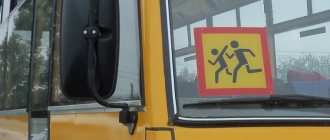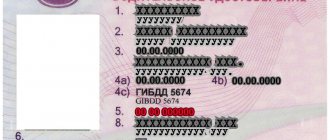Description
Like most warning signs, 1.13 and 1.14 are designed in the form of a triangle with a red edge. These signs are designed to attract the attention of drivers with bright colors and warn of possible danger. On road signs indicating a descent or ascent, the slope of the road with percentages is symbolically depicted.
The slope is calculated as the ratio of the height of the climb and the distance traveled, based on a 100-meter segment of the path. Indicated as a simple fraction or as a percentage in geodesy; On road signs, the steepness of slopes and inclines is indicated only as a percentage.
Example: in front of us is a sign “Steep climb” indicating 12%. If we have this opportunity and look at the road from the side, we will see that the angle of inclination in this place is approximately 12 degrees relative to the horizon. If you travel a distance of one kilometer on a road with a 12% slope, you will rise or descend 120 meters.
In accordance with the prescription of paragraph 11.4 of the set of traffic rules, it is strictly forbidden to overtake at the end of the climb.
Why is the steepness of slopes measured as a percentage, and why do drivers need it?
Surely you have already come across warning road signs 1.13, also known as “Steep Descent”, and 1.14 (respectively, “Steep Ascent”). And one of the drivers definitely noticed that the slope is indicated not in the usual degrees, but as a percentage. Degrees are the same in temperature and in alcohol. Relatives, understandable. Why complicate things? It's time to sort out this misunderstanding and find out how this information can help motorists when driving.
Imagine the situation: you are driving outside the city and come across a road sign in front of you, warning drivers that there is a rise ahead with a slope of 10%. As in the picture above. Right away in my head: 10% – how much is that? But if we say that it is almost 6 degrees, will this make it any clearer to you?
It is important to understand here that the road is constantly changing its angle of inclination, so it will be difficult to determine this indicator in degrees. But the slope of the road as a percentage is easy! This is the number of meters by which the roadway will fall or rise after 100 meters of travel. That is, in our case, driving 1 kilometer along a road with a slope of 10%, you will rise 100 meters relative to the original point. If you remember the school trigonometry course, the number on the road sign is the tangent of the angle of inclination of the roadway, expressed as a percentage. However, don’t bother: they’ve already calculated everything for you a long time ago, and you just need to learn how to use this data.
Why do you need to know the steepness of a slope?
It turns out that the tangent of the angle of inclination is equal to the coefficient of adhesion to the road surface. If you are driving on dry asphalt, this figure is about 0.7 (provided that you do not have “bald” tires). It started to rain and the coefficient of adhesion to wet roads immediately dropped to 0.5. And if it happens in late autumn, and after a rainstorm it “successfully” froze, then the asphalt turns into a real skating rink. And here the coefficient of adhesion with the roadway is reduced to a minimum - less than 0.1. What does this mean in our situation, when we are climbing a hill with a slope of 10%, or 0.1?
You must understand that if you stop on a slope, then, at best, you will not be able to move off to continue your journey; at worst, the car will easily roll back. And no amount of driving experience or even the best studded tires will help the car stop until it rolls down the mountain. Because there is practically nothing connecting the wheels to the road. That is why the Traffic Rules (Section 11.7 of the Traffic Regulations) force drivers descending from a slope to yield to the oncoming flow going uphill (even if the obstacle is located on their half of the road).
Why is a long descent dangerous?
Driving down a steep mountain is no less dangerous. During a long descent, when you continuously press the brake pedal, your car may overheat and the brakes may fail. To prevent this from happening, we advise you to learn how to “lower speed” using the engine, gradually reducing gears. The steeper the descent, the lower the gear should be. We wrote in detail about the features of engine braking in our blog earlier.
By the way, many people do not pay much attention to the “Steep Descent” or “Steep Ascent” signs. Especially when a small percentage of the slope is indicated there. In vain. It often happens that in bad weather conditions (for example, in snowfall, fog or when it is dark), a motorist may simply not notice small but long descents or ascents. Namely, it is on them that the brakes most often overheat. So we don’t miss the signs. Would officials spend money from the local budget if this section of the road did not pose any danger?
Difference in signs
And finally, we’ll tell you how to distinguish the descent and ascent on the signs. Of course, most often you can understand what is in front of you purely visually. But not always. The weather makes adjustments, and in heavy snow, a small long descent can easily be overlooked, but the car’s braking system will. So in bad weather you should pay special attention to the signs installed on the side of the road.
Your left hand will help you distinguish between uphill and downhill on road signs. Direct your palm along the inclined line, above which the steepness of the slope is written as a percentage. If your fingers are pointing down, it means there is a steep descent ahead of you; if it’s up, it means you have to climb a mountain.
Fortunately, the greatest longitudinal slopes on Russian roads do not exceed 6-7% on flat and hilly terrain and 9-10% in the mountains. Of course, in coastal cities there are roads with quite serious slopes, the steepness of which exceeds all existing standards. But now we know where the danger is, which means we can overcome even the steepest ascents and descents. Good luck on the roads!
Explanation
Often drivers do not immediately understand which sign is in front of them: a steep descent or an ascent. Especially if the slope is small or it is snowing and visibility is difficult.
To quickly navigate the situation, use the following simple tips:
1The principle of reading road signs is no different from reading text, that is, from left to right. By moving your eyes from left to right, you can easily understand whether this road sign means up or down.
2Using the palm of your left hand, visually repeat the slope of the road shown on the sign. If the fingers point down, this means that there is a steep descent ahead, but if on the contrary, we are going uphill.
Road sign steep descent
The steep descent sign is provided for in the rules established regarding movement on the roadway.
Traffic regulations help motorists navigate the road. They can inform the driver about descents and ascents, and other dangers on the highway. It is necessary to assume that a person is poorly oriented in an unfamiliar area.
A road sign indicating a descent is installed at a certain distance before the car begins to descend the hill.
What signs indicate a raised road?
A sign familiar to many drivers - a steep climb is provided for in the traffic rules. It has such a meaning that soon there will be a steep climb on the road. The road in a certain section rises up some distance.
Kosogor says that on the uphill and downhill section, traffic will be somewhat difficult for motorists. The driver, upon seeing the sign, must understand that danger awaits him ahead. The main requirement in this situation is to comply with established safety rules.
The speed in this area should be reduced. The transmission on the car is selected optimal for the conditions created.
The sign in question can be found in the following places:
- at a distance of approximately 70 meters to the section of the road where danger awaits the driver (this rule applies near populated areas);
- the same sign awaits a person approximately 200 meters from a sharp rise (this sign is installed outside a populated area).
The metro is not reflected in such pictures. Often the signs in question can be seen on the road in conjunction with other symbols. Such symbols will foretell that a certain distance remains to the place where danger awaits the driver.
In addition, they warn about how many meters the driver will drive along a steep slope.
It is required to distinguish such a sign from some other signs; for this they are trained in special schools for motorists.
A driver who intends to cross a dangerous section of the highway must understand that he has an advantage when moving. Traffic rules should be taught well so as not to create a danger for other drivers.
Downhill warning
The descent sign is used so that the motorist has the opportunity to react in time to a decline in the road. If movement is carried out using a bicycle, the person must also know that the road ahead is steeply descending. This kind of steep descent is found quite often on the highways.
There are situations when a person cannot distinguish between a sign that points to the road down and up. In this case, you need to use your left hand. It is positioned so that it is directed along the slope line. A good guide is a sign that displays the number and percentages.
If a person’s fingers are pointing down, this indicates the presence of a descent on the plate; otherwise, an ascent is depicted.
If you indicate that the road should go down further, you should give way to those who are going up. Underground passages in such places are extremely rare. This is due to the fact that dangerous descents take place outside the city.
If dangerous weather conditions arise, in particular fog, ice or snow, it is quite difficult for a motorist to determine that there are ups or downs on the highway.
The dangerous descent sign helps in this situation to orientate oneself in the direction and speed of movement.
The slope, according to the letter of the law, requires that the motorist yields to the oncoming car. This rule should not be forgotten. It also operates behind the scenes on stairs. Snowboarding and skiing do not require the presence of such signs on the slopes. A sign for such a descent is installed in certain places.
It is not news that cliffs on roads are quite common. This suggests why the legislator establishes the advantage of a car going up a hill. These signs do not apply to aircraft.
The location of signs foreshadowing the presence of ascent or descent depends entirely on:
- How far is the road section from the city or town? This rule applies to those areas where danger awaits the motorist.
- Visibility on the route section is taken into account.
This will mean that a sign will be installed at a distance of up to two hundred meters when the unevenness of the surface is located far from cities and other areas, but if it is nearby, then the distance is reduced to 70 meters. In English, nothing is reflected on the sign. They often indicate the number of meters to the dangerous area. Nothing is reflected in degrees. The door is not depicted on such signs.
Nuances
Alupka has no synonyms, since it is a city located in Crimea. It is worth considering that sleep for a motorist who is on the road for several days is as important as the availability of water and food.
Otherwise, attention is scattered and there is a possibility of becoming the culprit of an accident. The sign is installed in some situations and in populated areas. In this case, the sign is located at a distance of 50 to 100 meters from the place of danger.
When we are talking about out-of-bounds territory, the distance increases to 300 meters.
In addition, nearby can be installed:
- a sign reflecting the distance to the object (reflects the number of meters to a dangerous descent or ascent);
- signs are also placed that help to navigate how long such a section of the canvas will last.
It is worth drawing the attention of car enthusiasts to what is reflected as a percentage on the plate, however, in fact it should be considered as degrees. For example, when the plate displays the number 100 with a percentage, this indicates a slope of 45 degrees. These designations are used because the adhesion of the automobile surface to the road surface is required to indicate.
If the road is wet, then this coefficient will be less than 0.1. When the driver sees 10 and percentages on the sign, he must keep in mind that his experience and expensive tires will not help him stop on the descent in this situation.
When a person decides to leave a car on such a slope, he should remember that after rain or other types of precipitation there is a high probability that the vehicle will roll down on its own.
There is no need to reduce the significance of the signs in question, since in practice there are often cases when cars roll down slopes on their own. In addition to these provisions, it is necessary to take into account that depending on the weather outside, there is a change in grip on the road.
In the cold season, in particular when it is snowing and there is wet ice on the road, the grip becomes less than 0.1. This, in turn, indicates the extreme danger of those descents and ascents in front of which there is a sign with 10 or more percent. In some situations they are completely insurmountable.
When the descents are long, it is most effective to brake using the engine. That is, the steeper the slope, the lower the gear you should choose.
You also need to pay attention to the fact that drivers going up the slope have an undeniable advantage over those going down. This means that the person descending must, if necessary, brake and let the oncoming car pass.
Particular attention should be paid to signs when there is bad weather or poor visibility on the road.
Source: https://avtoved.com/pdd/znaki/krutoy-spusk
Coverage area
Important!
The main task of a group of warning signs is to signal possible unforeseen situations that may arise along a given section of the route. Therefore, it is logical to place them at some distance from the dangerous area so that the driver can concentrate and think through his further actions.
Based on this, signs 1.13 and 1.14, like most others, are placed 50-100 meters before the start of a steep descent or ascent within populated areas and 150-300 meters outside the city.
Road signs can be combined with information plates:
- 8.1.1 indicating how many meters are left to the dangerous section of the road;
- 8.2.1 with information about how many meters the dangerous section of the roadway will last.
In a situation where, after a steep descent, the road immediately begins to rise, sign 1.14 will be placed directly at the very beginning of the ascent.
Warning sign for raising the road
If we consider a warning sign such as 1.14 (“Steep climb”), the car owner should remember that a relatively dangerous and steep road awaits him ahead, rising a certain distance upward. Driving on steep descents and ascents is usually difficult, and the driver must be warned about the approaching dangerous section of the road. The main thing that is required of every motorist is to maintain safety, trying to reduce the speed to reasonable limits and choose a more acceptable gear that will make it easier to overcome the existing rise.
Designation 1.14 can usually be found in several cases:
- near (about 70 m) a dangerous section of the road, which is located near a village or city;
- not far (about 200 m) from the sharply upward road, located far from the populated area.
Road sign “Steep climb”
Car owners most often encounter the “Steep climb” sign together with special signs, in particular with the designations 8.1.1 and 8.2.1. The first of the signs, as a rule, indicates to the driver the exact distance to the section where the road begins to climb uphill, and the second indicates how long such a section of the journey will be.
In addition to all of the above, a driver planning to drive along a dangerous section of the road must remember that the car that will move up will have an advantage for movement.
Comments
If vehicles pass in places where signs 1.13 and 1.14 are in effect, it is worth remembering that the one moving uphill has priority in traffic. This rule is regulated by paragraph 11.7 of the traffic rules.
Imagine the situation: you are a car driver and you are driving down a steep slope. There is an obstacle in the form of a landslide ahead, which completely blocks the path of an oncoming car moving uphill. The favorable outcome of this situation depends on your competent actions. According to the interpretation of clause 11.7 of the traffic rules, you must give priority right of passage to a car that is moving uphill, despite the fact that the obstacle is located in its lane.
This advantage was established due to the fact that stopping on an ascent and then moving up a hill is much more difficult than performing the same actions when descending: the car may roll back or stop the engine.
An obstacle is a stationary obstacle that has arisen on the way and impedes further movement along a given lane of the roadway. This could be a faulty vehicle, road damage, foreign objects, and much more. The traffic jam is not an obstacle.
Fines
Failure to comply with the requirements of road signs entails an administrative penalty. A detailed table of fines and explanations can be found on the traffic police website.
12.15 Part 1 Violation of the rules of oncoming traffic will entail the imposition of an administrative fine in the amount of 500 rubles.
12.15 Part 1 Incorrect positioning of a vehicle on the roadway or oncoming traffic lanes entails a fine of 1,500 rubles.
12.14 Part 3 Failure to comply with traffic rules and ignoring the rule to give way to a vehicle enjoying the right of priority, except for the cases provided for in Part 2 of Article 12.13 and Article 12.17 of the current rules - a warning or a fine of 500 rubles.










